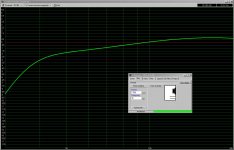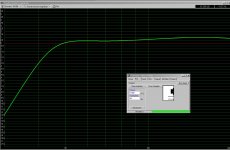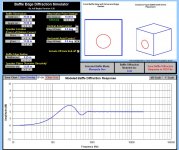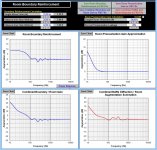years ago I remember reading an article by someone who measured the T/S parameters of his 416b in his Altec model 19 and found the factory cabinet was much too large for optimum results. Can anyone refer me to this article? Seems that Altec actually recommend 7.5 cubic feet as the optimum for a 416b but I thought I recalled the previously mentioned article as being somewhat smaller but I am not sure of that. Any assistance would be much appreciated. I have seen reflex designs as small as 7 cu ft in volume. Any Altec owners out there who have shrunk their model 19's with success? Thanks for any input. Best regards Moray James.
If it were me, I'd use something like WinISD Pro to investigate the situation. In my experience, going a little big on bass reflex volume isn't a problem, and in fact can have beneficial effects. Usually those "optimum" volumes come from canned programs. Not that they're wrong, they're just someone else's idea of optimum based on their set of criteria.
I think that the thread I read was one of Zilch's and the difference in volume was approx 3 - 3.5 cubic feet smaller than the stock 19 cabinet. That's a big deal even if the performance was the same but the smaller cabinet actually extends lower and the loading is superior. The 19 was simply pimped up to look the part of a high end expensive design. So the shift was from about 9.5 cubic feet per model 19 cabinet to about 7 cubic feet per cabinet T/S optimized. Thanks to those who responded. Best regards Moray James.
There could be other reasons for the size and shape. The 811 horn is quite large and with the 802 driver extends almost to the back of the cab. To get the horn at a decent height, you need a tall-ish box. Esthetics also play a role - like them or not.
All that aside, I have 19's and a number of Altec horns and bass drivers that I've been playing with for over 10 years. The larger boxes sound better to me and many others. I know it's sacrilege to question the results from Zilch, but he measured and assumed that whatever measured the way he thought it should was best. I've measured my 416's with woofertesterII and used a variety of box programs including winisd and you do get a smaller box than the 19. I got something in the 5 cuFt range if I remember correctly. Sounded anemic to me.
There are many who swear by his Z19 crossovers but there's also a lot that tried them and went back to the Altec stock version (myself included).
If there was a much smaller cabinet that sounded better, ie went lower and sounded more natural, I would like to copy that design and get the 19's out of my room. It also has to have the 811's inside the cabinet, I don't really like the look of the horns sitting on top. Do you have such a design?
All that aside, I have 19's and a number of Altec horns and bass drivers that I've been playing with for over 10 years. The larger boxes sound better to me and many others. I know it's sacrilege to question the results from Zilch, but he measured and assumed that whatever measured the way he thought it should was best. I've measured my 416's with woofertesterII and used a variety of box programs including winisd and you do get a smaller box than the 19. I got something in the 5 cuFt range if I remember correctly. Sounded anemic to me.
There are many who swear by his Z19 crossovers but there's also a lot that tried them and went back to the Altec stock version (myself included).
If there was a much smaller cabinet that sounded better, ie went lower and sounded more natural, I would like to copy that design and get the 19's out of my room. It also has to have the 811's inside the cabinet, I don't really like the look of the horns sitting on top. Do you have such a design?
Last edited:
The Altec 416-8b models to -3db at 50Hz in a 4.5 cuft Qt= 0.7 ported box.
The Altec 416-8b models to -3db at 28Hz in a 12 cuft MLTL ported box.
There are several different box tunings which might better match your room gain and speaker placement with respect to walls/corners and floor bounce.
There are a few different T/S parameter versions of Altec and GPA 416-8B speakers.
The Altec 416-8b models to -3db at 28Hz in a 12 cuft MLTL ported box.
There are several different box tunings which might better match your room gain and speaker placement with respect to walls/corners and floor bounce.
There are a few different T/S parameter versions of Altec and GPA 416-8B speakers.
Attached graphs for 7.5 cuft ported box tuned to 35Hz and 42Hz. Your room gain and near-wall placement can add to a flat'ish response.
For the absolute best 20-20Khz sound, you could put the 416-8B in a small well stuffed box and add a real woofer with equalization. Several designers also like the sound of the 416-8B with an aperodic port loading, plus a real woofer.
For the absolute best 20-20Khz sound, you could put the 416-8B in a small well stuffed box and add a real woofer with equalization. Several designers also like the sound of the 416-8B with an aperodic port loading, plus a real woofer.
Attachments
I guess where my thoughts fell to the wayside was that I actually built the boxes and listened to them before making my mind up on what sounded best.
I also measured my actual drivers and used real data rather than depending on the often incorrect data from the many Altec information sites available on line. One advantage that I had with this method was that I got to measure eight 416's myself and use facts instead of the somewhat hopeful results from 40 years ago.
Once again I say that the larger boxes sound better, not that the measurements are perfect or that you'll prefer them. I like data but I think a lot of it is wank.
I also measured my actual drivers and used real data rather than depending on the often incorrect data from the many Altec information sites available on line. One advantage that I had with this method was that I got to measure eight 416's myself and use facts instead of the somewhat hopeful results from 40 years ago.
Once again I say that the larger boxes sound better, not that the measurements are perfect or that you'll prefer them. I like data but I think a lot of it is wank.
Plots of a simple room/diffraction model as a reminder how room dimensions and speaker placement can change the box tuning for optimum in-room sound. More detailed models include all_walls + ceiling + carpets + drapes + furniture, etc..
Explains why some folks go digital and just push a button to equalize many sins.
Explains why some folks go digital and just push a button to equalize many sins.
Attachments
Attached graphs for 7.5 cuft ported box tuned to 35Hz and 42Hz. Your room gain and near-wall placement can add to a flat'ish response.
For the absolute best 20-20Khz sound, you could put the 416-8B in a small well stuffed box and add a real woofer with equalization. Several designers also like the sound of the 416-8B with an aperodic port loading, plus a real woofer.
The "real" woofer statement says it all. Vintage speakers, even big ones just don't go low by modern standards, so optimizing them for that role doesn't make a lot of sense. They all sound much better with modern subs and a little deep bass rolloff. 19's in smaller cabinets just wouldn't look right. I have L300's and I stuff the ports tight and roll them off into a swarm of subs at 50 Hz.
Don't know of any article, but Altec recommended <6 ft^3 for ducted port and >6 ft^3 for bass reflex. 7.5 ft^3 was optimum sealed.
The M19 is a ~ 8.35 ft^3 net BR, so not too large since a T/S max flat is around 12.3 ft^3 and the pioneer's so called 'ideal' alignment makes it ~18.38 ft^3 for a Fs tuning using the original T/S specs.
Note that the 416-8C was audibly under-damped in the M19 though, so this may be where the confusion lies.
I did two different downsized M19s for some folks; one that condensed it into a simple rectangular cab of the same net Vb rather than the three cab + base assembly and the other is downsized closer to a M14 with a slot duct vent, but if they got built I don’t remember them posting/PMing anything.
Regardless, it obviously can be shrunk quite a bit using ~aperiodic loading with the trade-off of course being a higher F3, etc..
GM
The M19 is a ~ 8.35 ft^3 net BR, so not too large since a T/S max flat is around 12.3 ft^3 and the pioneer's so called 'ideal' alignment makes it ~18.38 ft^3 for a Fs tuning using the original T/S specs.
Note that the 416-8C was audibly under-damped in the M19 though, so this may be where the confusion lies.
I did two different downsized M19s for some folks; one that condensed it into a simple rectangular cab of the same net Vb rather than the three cab + base assembly and the other is downsized closer to a M14 with a slot duct vent, but if they got built I don’t remember them posting/PMing anything.
Regardless, it obviously can be shrunk quite a bit using ~aperiodic loading with the trade-off of course being a higher F3, etc..
GM
- Home
- Loudspeakers
- Multi-Way
- T/S to shrink the Altec model 19?




